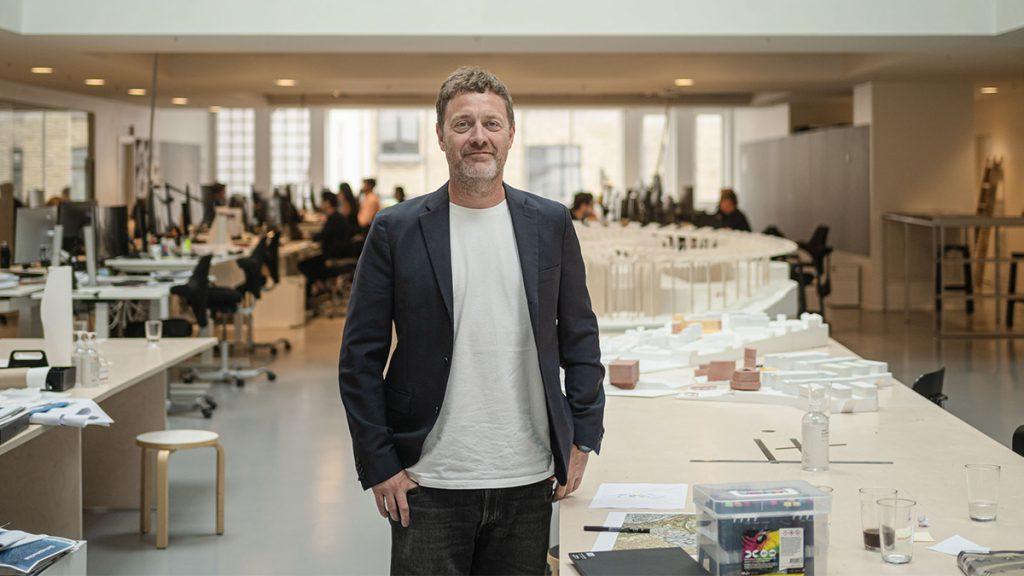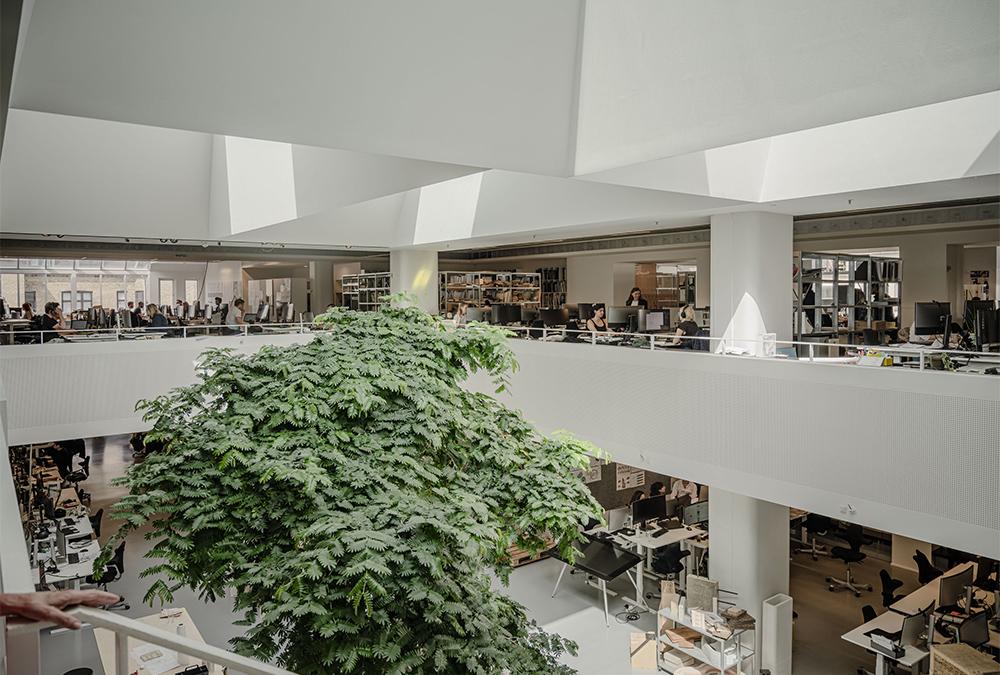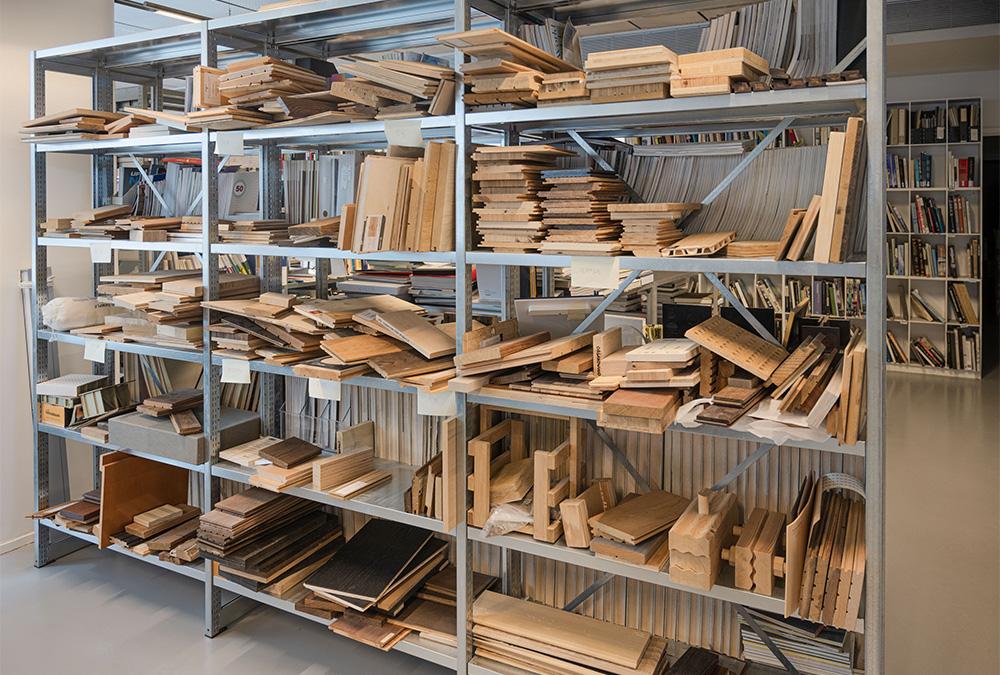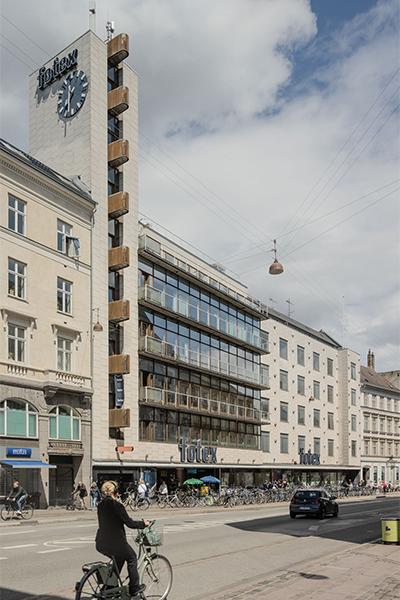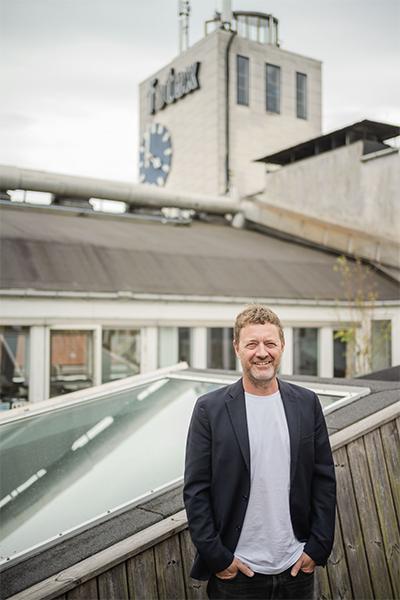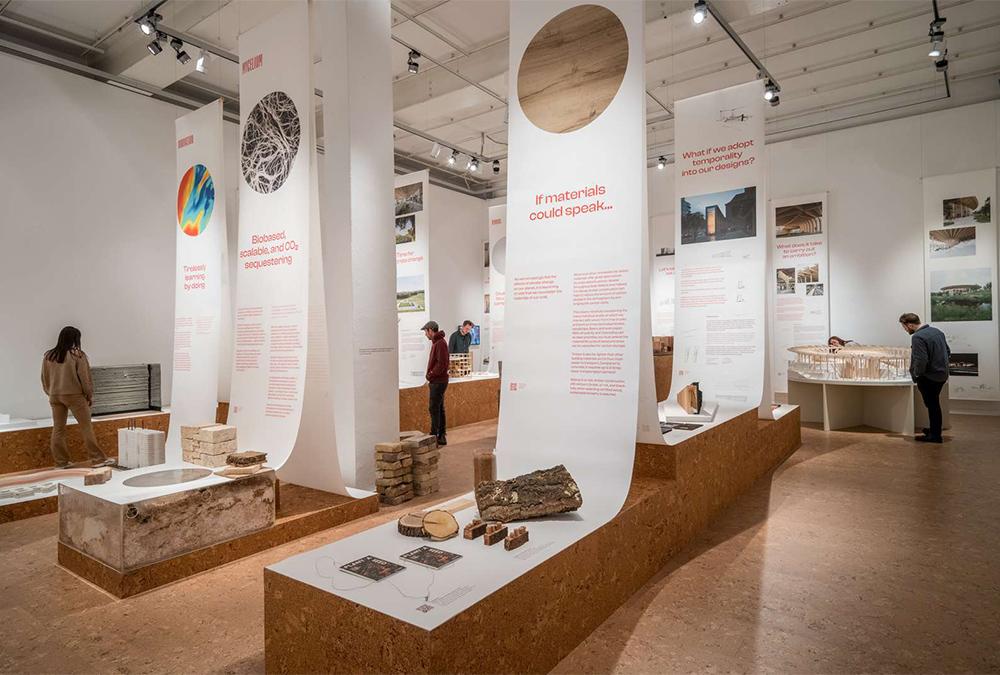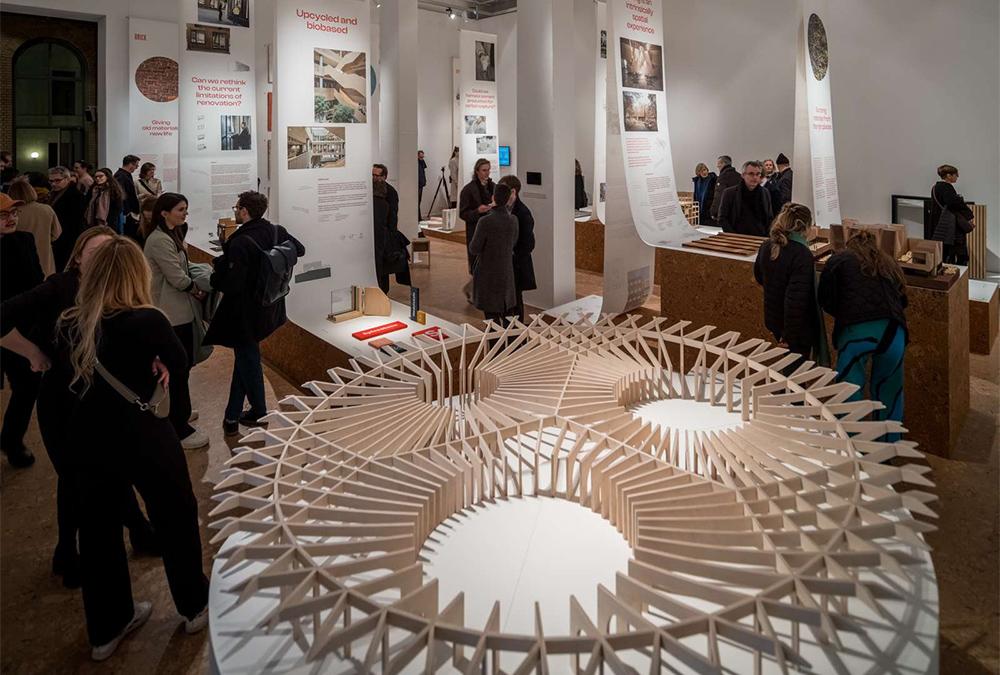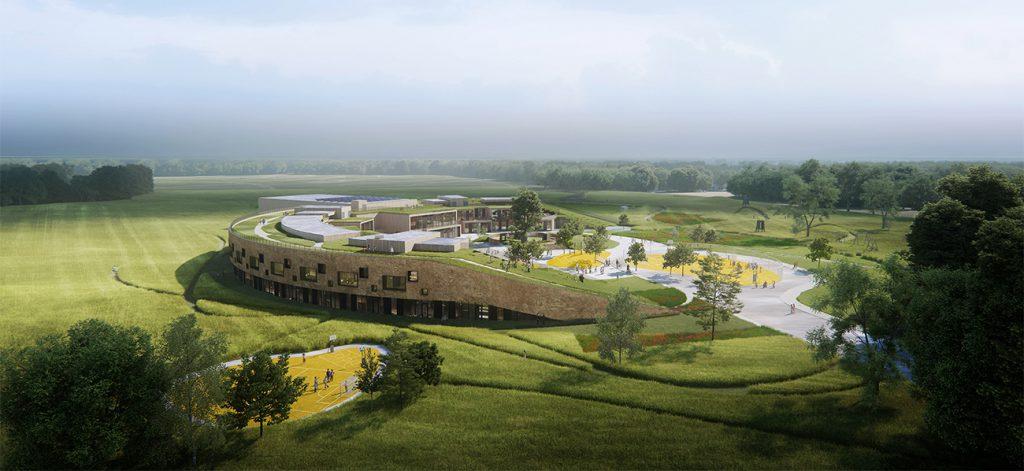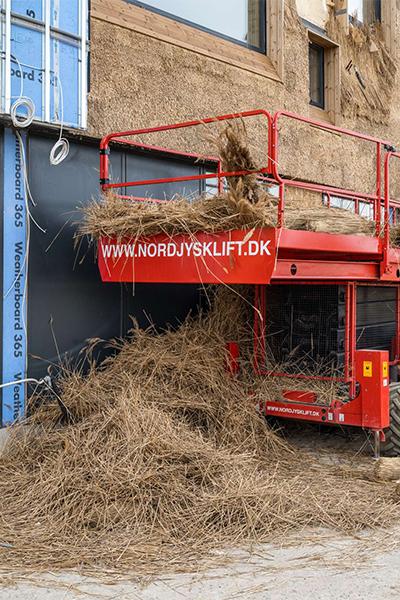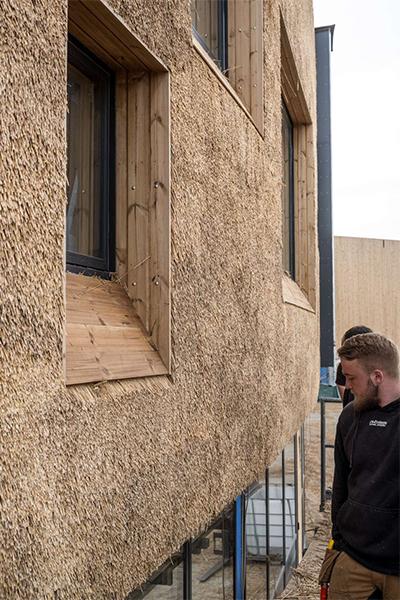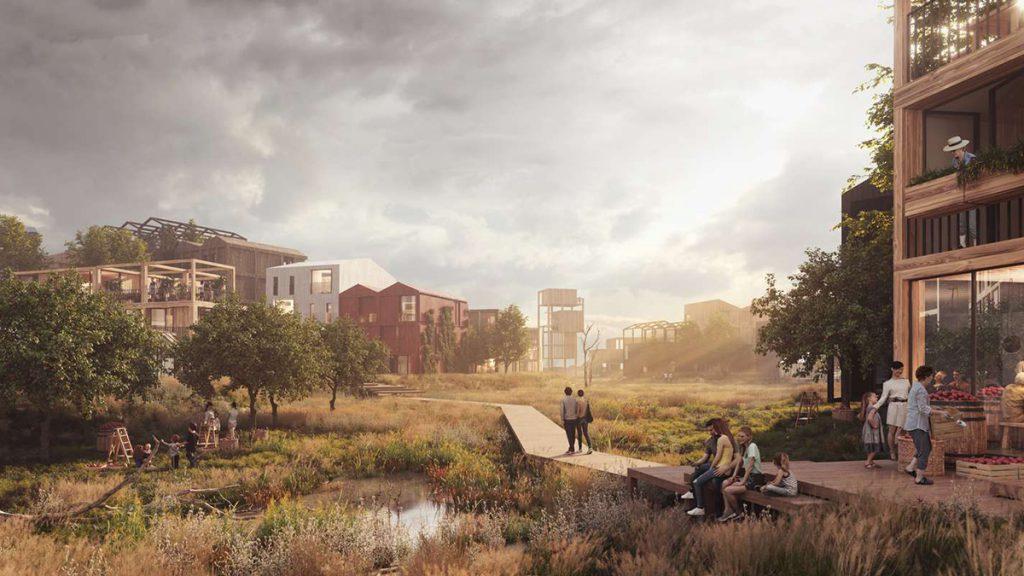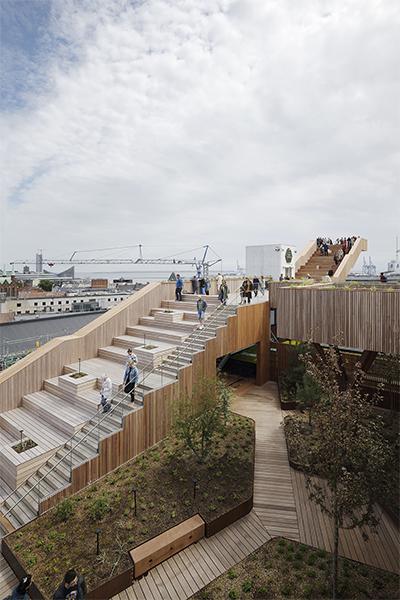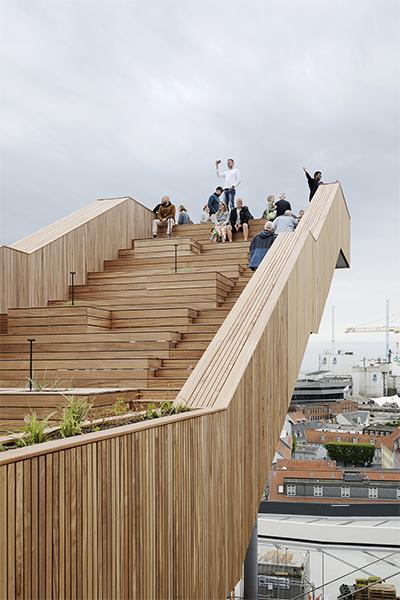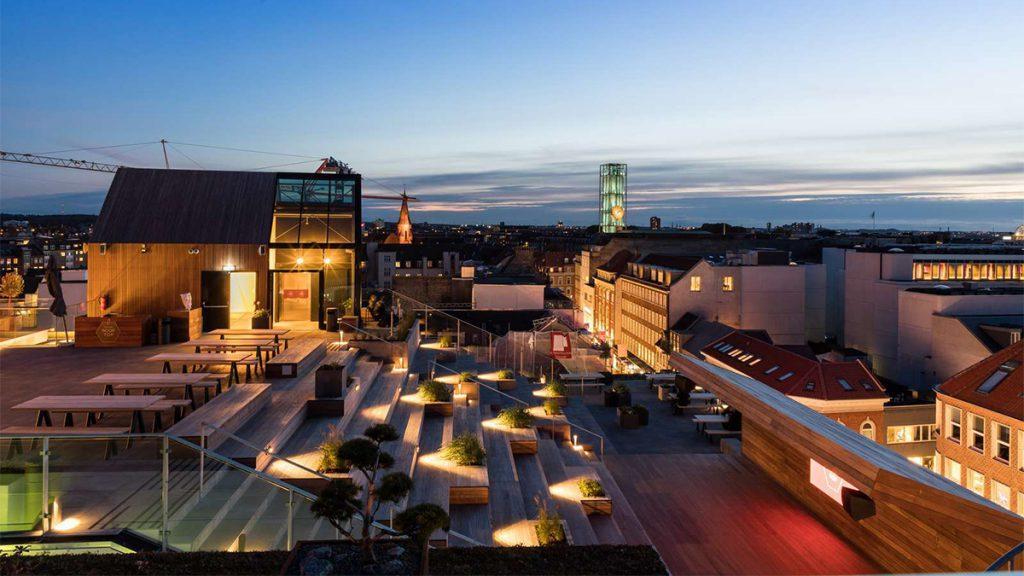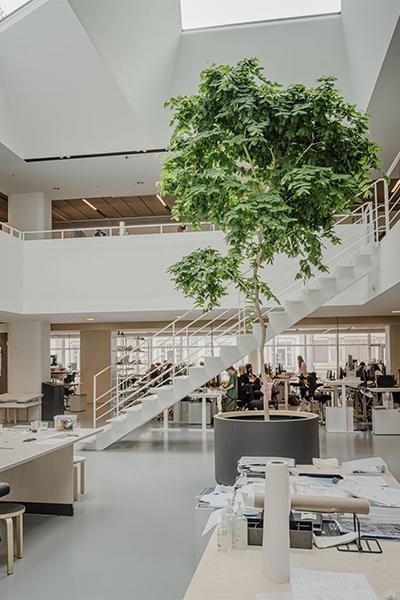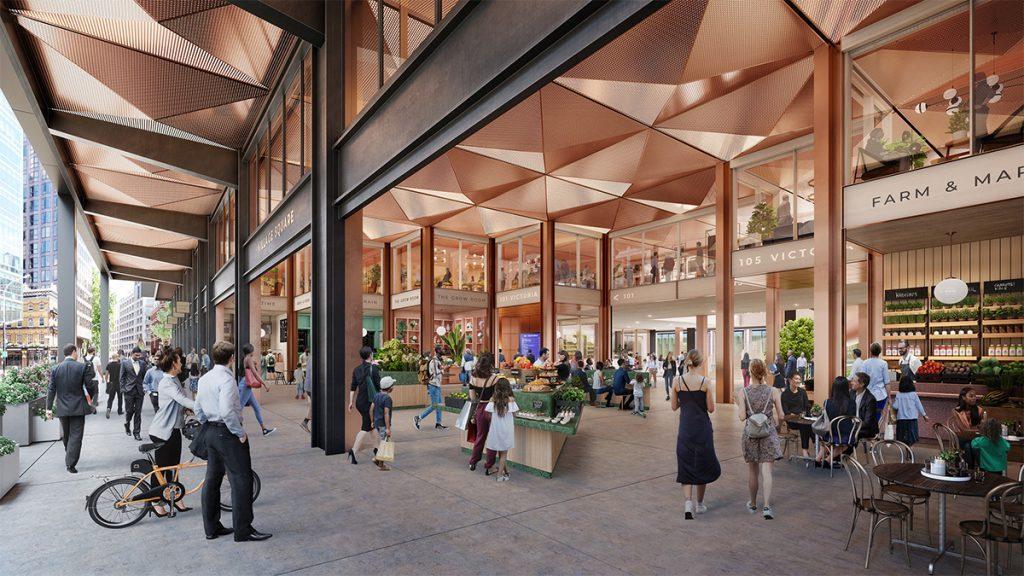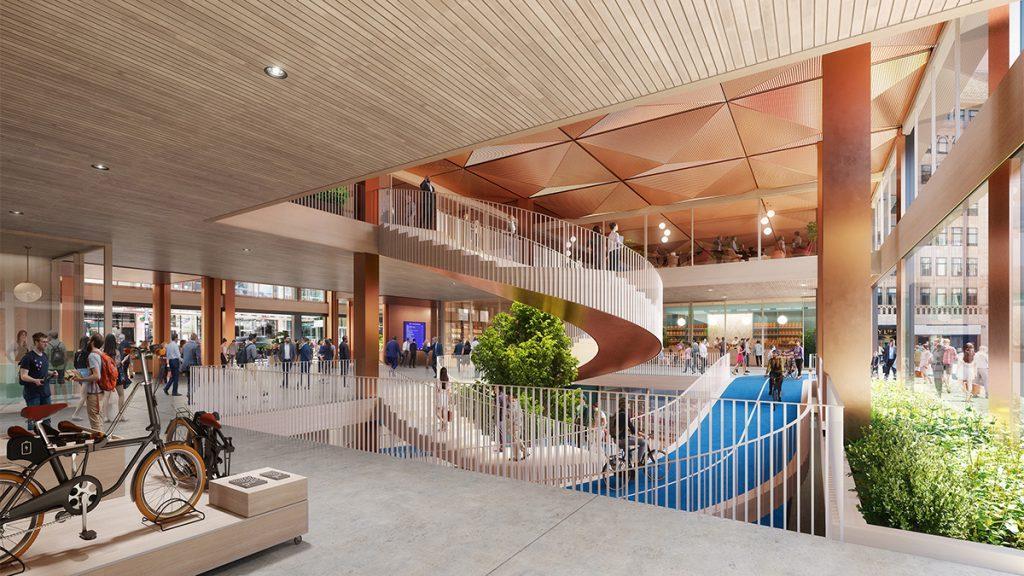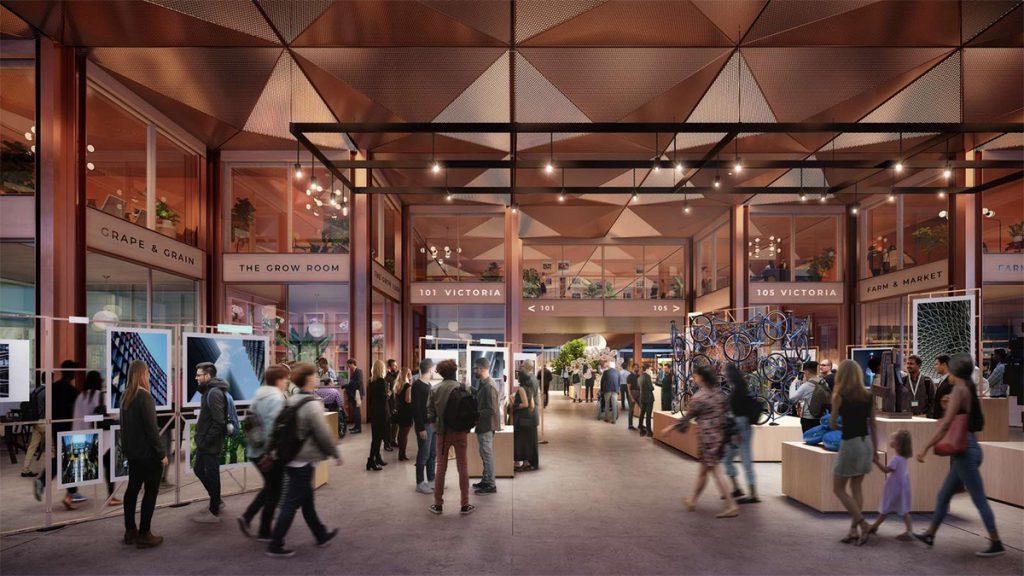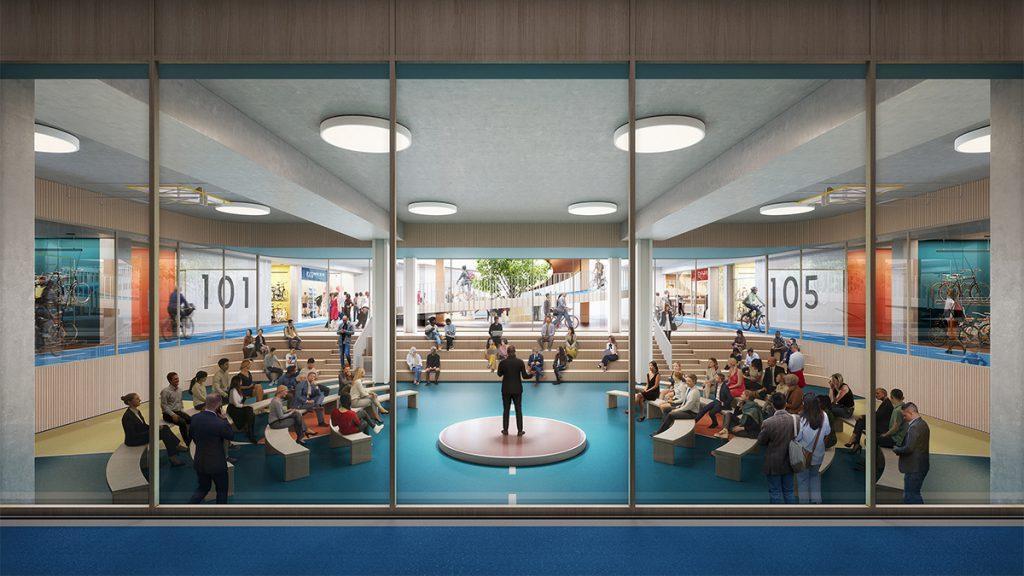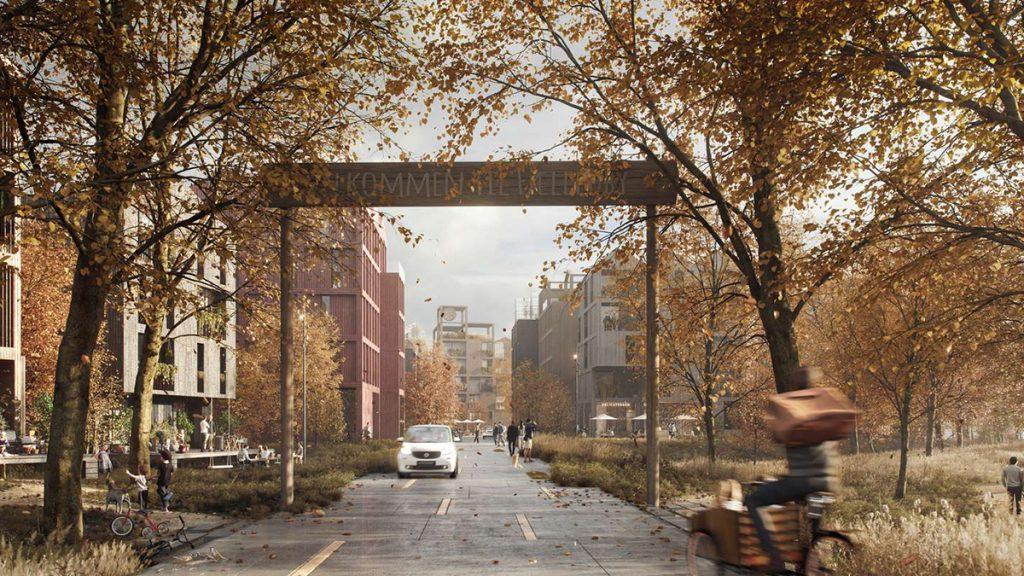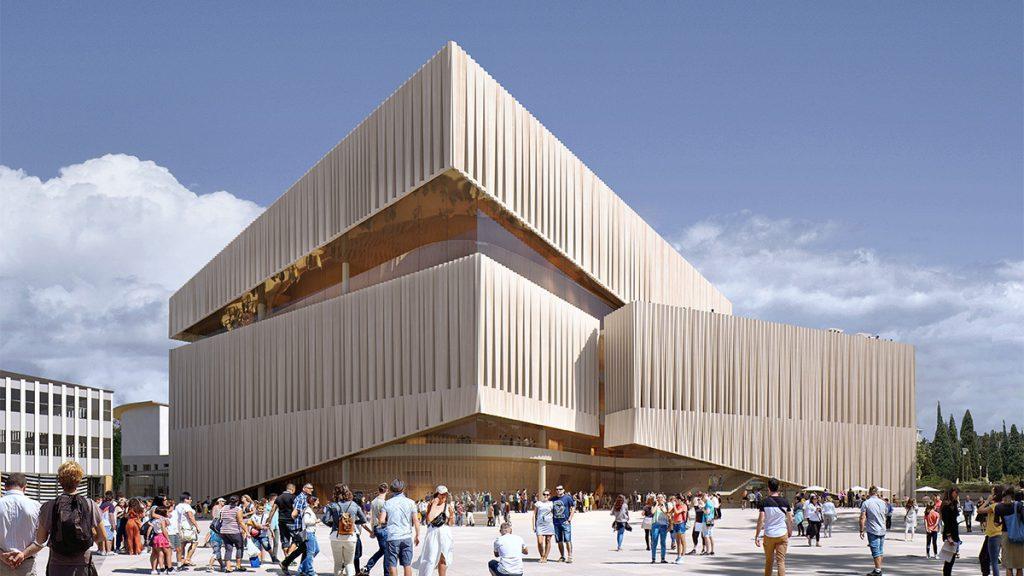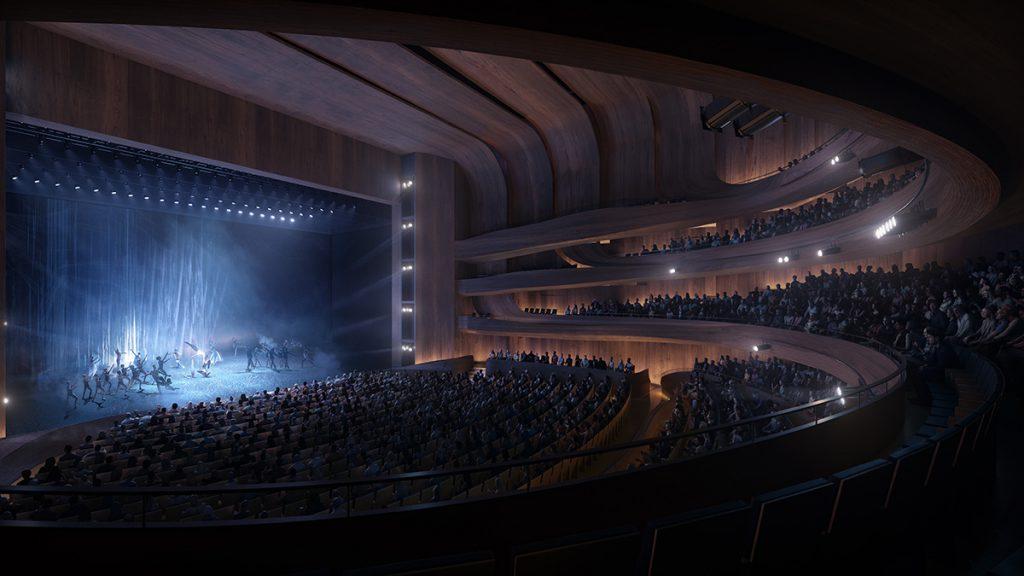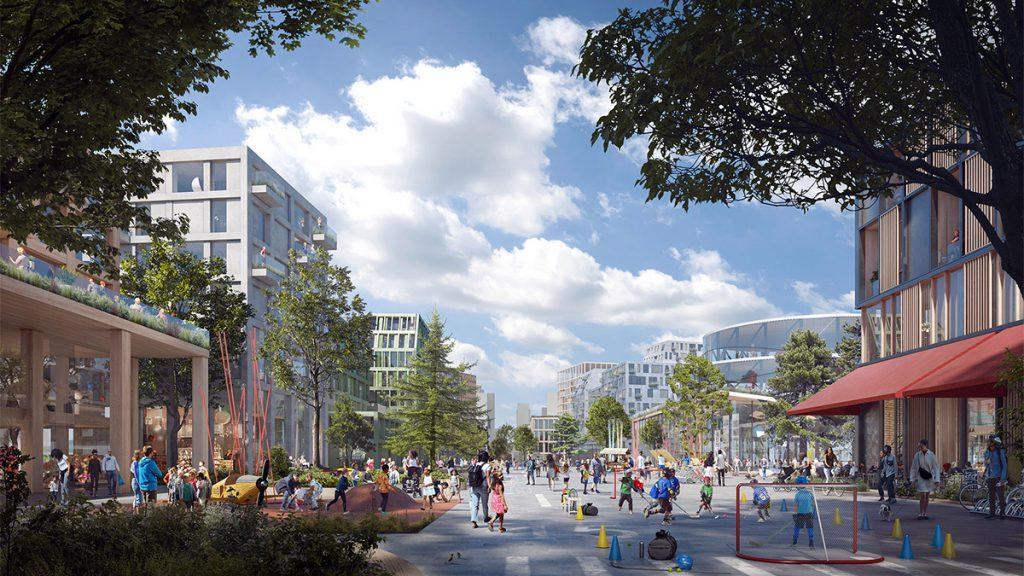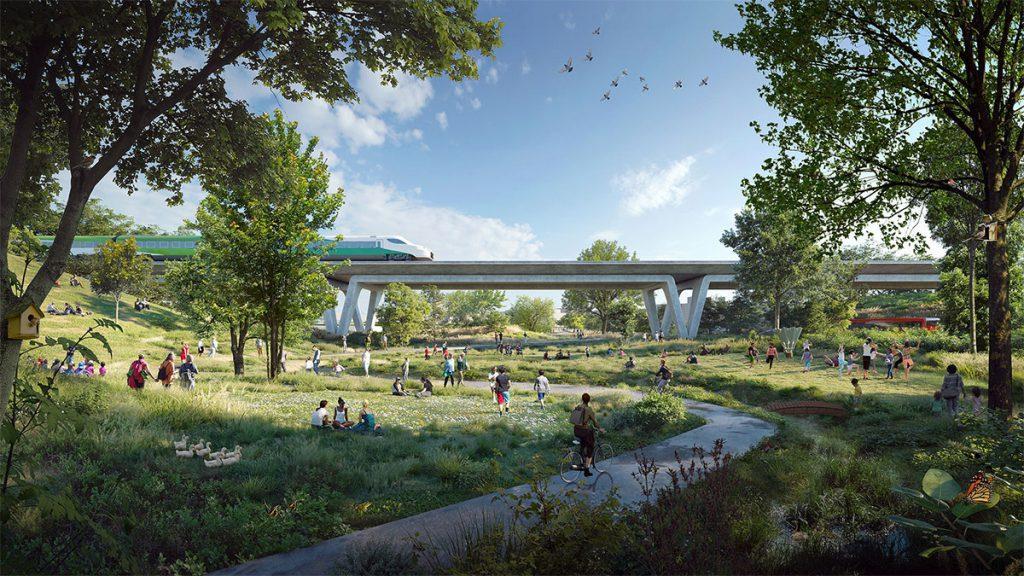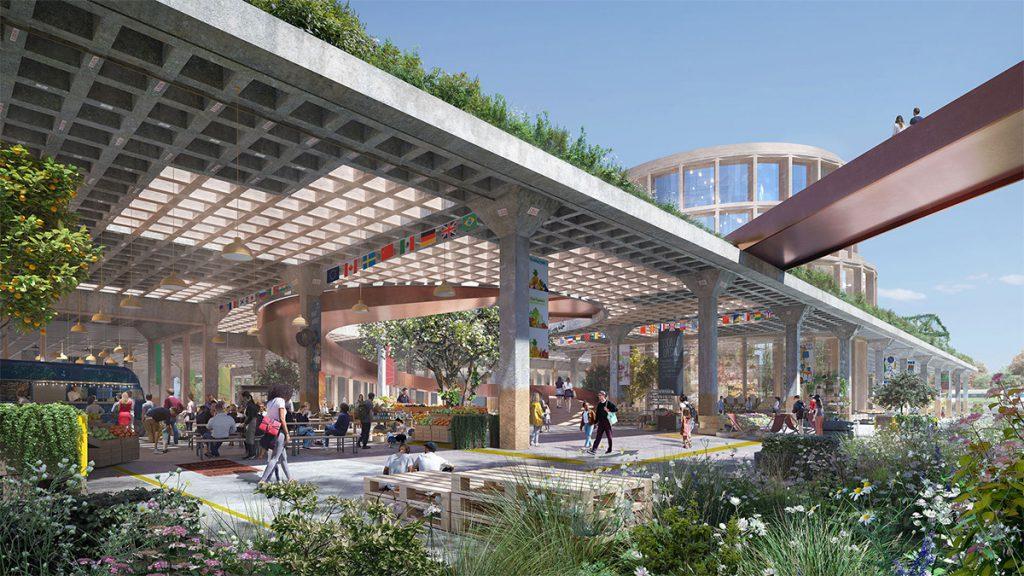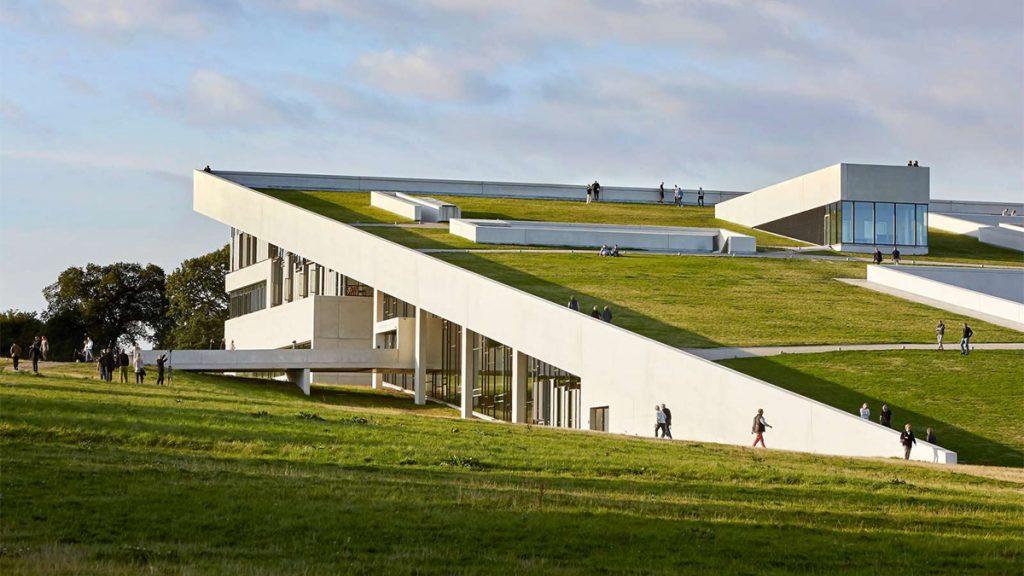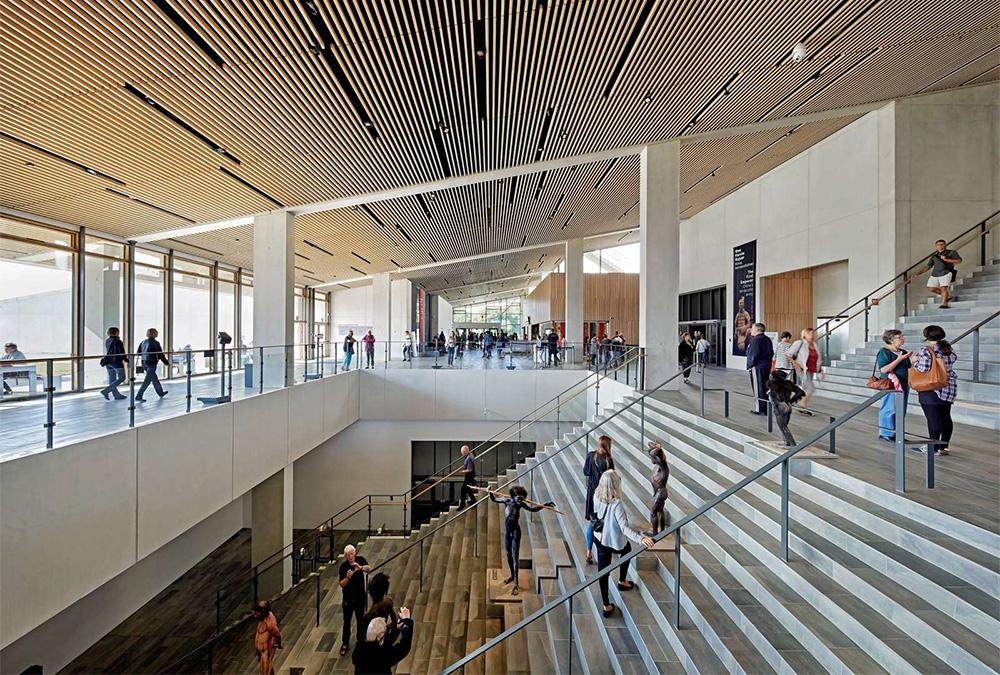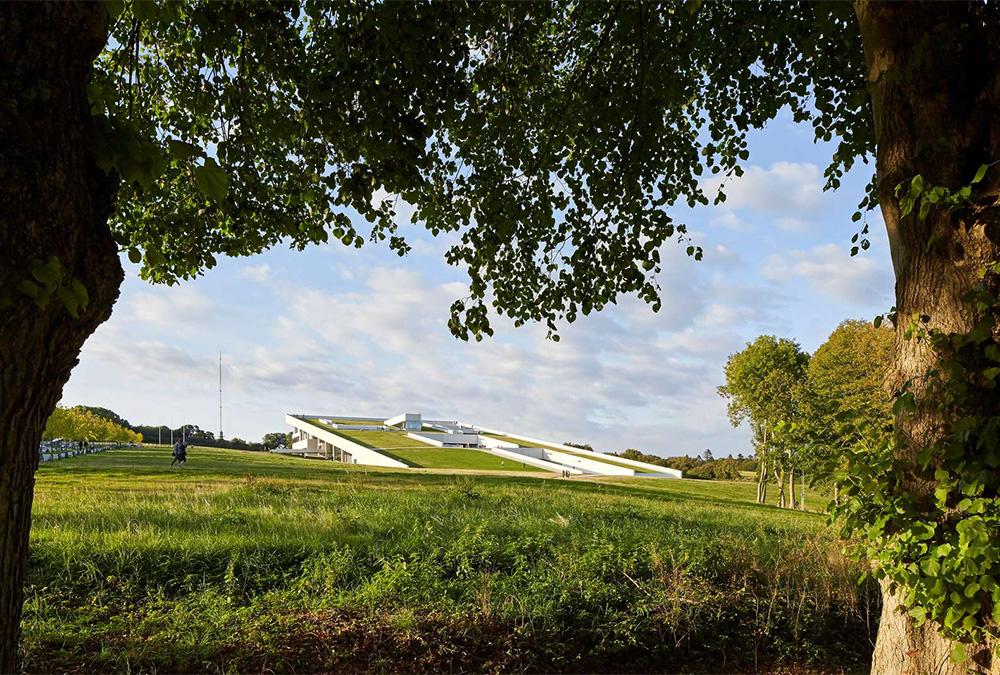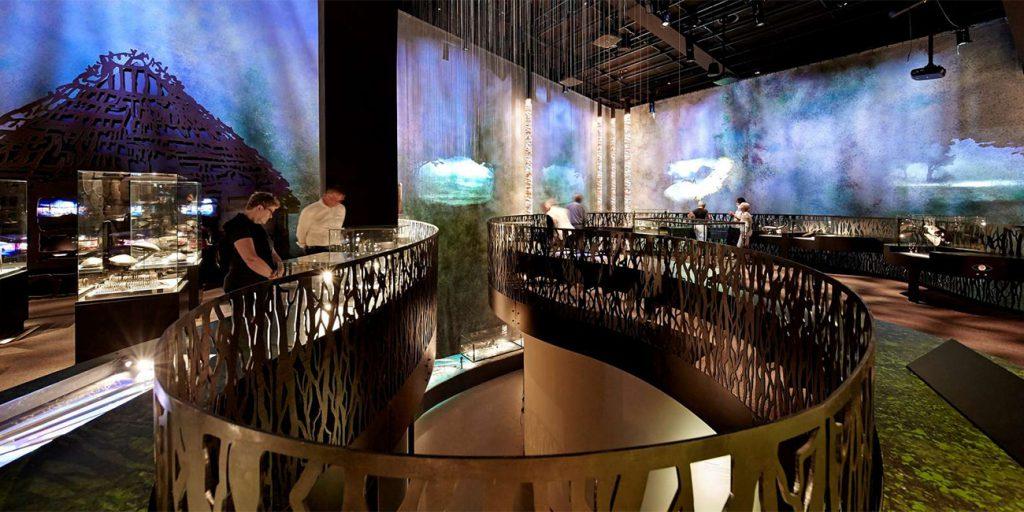“High time to act”
Henning Larsen Partner and Global Design Director Jacob Kurek oversees highly diverse projects around the world. In this interview, the prominent architect describes how sustainable thinking can be implemented everywhere and what is key to its success.
Meeting the partner of multi-award winning architecture studio Henning Larsen at their Danish headquarters requires precise planning. As Global Design Director of this internationally renowned company, Jacob Kurek is usually at work on one of the countless projects far from his home country. We took an opportunity to visit him in his Copenhagen studio.
The marvellous “world” of Henning Larsen
Viewed from the outside, there is no indication of the modern, light-flooded office that is located on the top floors of the old house at 76 Vesterbrogade. But once inside, an entirely different world opens up: on the first level, many individual and shared workspaces are filled with people busy working on different projects. In between, detailed models sit enthroned, some of which are crafted from waste materials such as coffee grounds and paper. A bright, airy atmosphere has been created by keeping the central part of the office open on the upper floors.
A comprehensively stocked materials library can be accessed by every employee and supports planning work. Of course, there are also separate rooms for conferences or focused working away from the busy main area for collaborative activities. A staircase leads up to the next level where, among other things, a canteen with table football, an outdoor terrace and a well-tended rooftop garden provide space for relaxed breaks.
Design for a better world
The Henning Larsen headquarters have everything that is needed for a pleasant working environment. And guests are made very welcome. After all, as Henning Larsen partner Kurek emphasizes, the aim is “to demonstrate through openness and transparency how the world can be made better by means of design”. After taking us on a tour of the office, he explained more about this in an interview.
What are the most important trends in your industry at the moment?
Jacob Kurek: I think there’s really a lot going on at the moment. In our upcoming exhibition “Changing Our Footprint” that opens on 16th November 2023 at the Danish Architecture Center, we are trying to show what the world is like right now and what we want to achieve. And how we can positively change the way we design and build today. Because we have to change something.
There is talk everywhere about the urgent need for change. But is enough actually being done?
There is a lot of talk about it, but unfortunately much less action. That’s why we’re trying to open up, to our competitors as well as to the construction industry as a whole. We want to make people aware that we all have to do something. And one way to get that going is to meet on common ground, communicate and share knowledge. By doing this, we can hopefully expand boundaries and perceptions and create a better future, better buildings and better design. So that we can all live healthier and happier lives.
Designing and building new things is always subject to political, legal and local constraints. Has it become easier to realize sustainable things?
Yes and no. It has gotten easier because now people understand better that if you don’t change your thinking now, you’re going to miss the boat. And the jetty we’re standing on is already on fire. But talking alone is not enough. You also have to act. We architects can’t do it on our own, as much as we’d like to. We need the builders, all the stakeholders and users. And above all, we also need the authorities to sit down at the table with us. Because after all, if local regulations and authorities don’t approve a design, even the best and most effective ideas remain on paper.
Realizing sustainable things has gotten easier because now people understand better that if you don’t change your thinking now, you’re going to miss the boat. And the jetty we’re standing on is already on fire.
Jacob Kurek, Henning Larsen Partner and Global Design Director
The comeback of timber construction comes to mind in that respect. For a long time, the regulations here were very strict, for example because the fire risk was considered to be high. In the meantime, however, high-rise buildings made of wood have already become possible…
That’s right.
How can architecture help promote solutions to pressing problems like climate change or cities that are far too dense?
I think we as architects have two roles. On the one hand, as listeners, making sure everyone has been heard and brought to the table. On the other hand – and I like to say this – we are the pioneers, gaining experience. We need to evolve, but not forget what we’ve learned. It’s about changing mindsets and designing buildings differently.
How do you approach this at Henning Larsen?
The best investment we made 15 years ago was establishing our internal Research, Development and Sustainability department. It has become one of our greatest assets. It’s not just about designing beautiful symbols, about feelings and what you believe in. It’s also about being guided by numbers and knowledge, being curious about other competencies and players in the construction industry, and then applying them where it makes the most sense.
Remaining curious and trying new things is important. It would be riskier not to be brave enough to do that. If you are not willing to invest in the future, you are not on the way up, but on the way down.
Jacob Kurek, Henning Larsen Partner and Global Design Director
So curiosity is very, very important. What matters is not just what I know today, but what I can know tomorrow. That’s a core part of our ambition, our motivation: you should never forget your playfulness and your curiosity. If you do, everything will stay the same – and you won’t bring about any change.
But trying new things can also go wrong. You might have an idea for making concrete more sustainable, try it out, and find that it doesn’t work. Doesn’t that make pioneering a risk even for companies as big as Henning Larsen?
It would be riskier not to be brave enough to do so. If you are not willing to invest in the future, you are not on the way up, but on the way down. The challenge we all face today is in the small R&D projects we all do today, with new technologies and more.
Why there in particular?
If you see that something works on a small scale, it’s about expanding it to be able to apply it on a larger scale. Because otherwise, again, we wouldn’t be able to have the positive impact we want. It’s about being able to take progress that we’ve made in, say, a 200-square-metre building and expand it to 20,000 or 200,000 square metres. That’s what we’re all focused on right now.
Unfortunately there is also a lot of greenwashing, because sustainability attracts a lot of media attention.
Architect Jacob Kurek
So it’s about “industrializing”, so to speak?
Yes, it is. Over the past 60 to 70 years we have also worked with prefabricated elements…
That was also the cheapest way, wasn’t it?
Yes, but also one that was driven by industry and the ability to build something prefabricated. That had some advantages. But it also had limitations. And those have now suddenly changed completely because we can now do 3D printed work in concrete, for example. It’s about minimizing the amount of concrete used. That and all the kinds of new steel, recycled materials, upscaling and more are the interesting part. Whether you can print the most difficult detail that allows anyone to build a house – almost like LEGO, which we Danes have all lived with since birth…
What would that do?
You might suddenly be able to skip two links in the big value chain. And then all the traditional micro-builders and contractors will have to adapt. Currently, they carry too much weight in this market. And we need to change that as well.
Green building and sustainability are on everyone’s lips. But what should really receive special attention in new projects?
I think we can agree on this: there’s too much talk and too little action. And unfortunately there is also a lot of greenwashing, because sustainability attracts a lot of media attention. At our studio, our specialized team ensures that we develop a better understanding of sustainability and that it is anchored in our designs. In many ways, you can say that we have less and less competition in this regard because we do what others only talk about. And that’s good for us… (laughs)
We will definitely see a huge change in the next few years.
Jacob Kurek, Henning Larsen Partner and Global Design Director
And how do the clients see that?
When we talk to big developers or pension funds today and they look at their building portfolio, they all see that something has to happen. Because what used to be worth its weight in gold will soon be devalued because it’s certainly not sustainable and healthy enough. So those where a lot of square metres are part of the assets, they have to rethink because otherwise they will face losses. We will definitely see a huge change in the next few years. And we will all be very busy.
But it’s not just about designing new things. It’s also about transforming the existing built environment, where there’s a lot of forgotten gold.
This brings me to the topic of “adaptive re-use”. But before that, another question: What about all those countries and regions where there is no money? People there need housing and safe places to live…
Unfortunately, we are so focused on what is happening in our own backyard that we forget about other parts of the world. But that’s not quite true either: here at Henning Larsen, we do a number of pro bono projects with a particular focus on social welfare. For example, we are co-designing a school in Uganda where children can get an education and take advantage of sports opportunities. We do this to help. And also to learn the building methods of local communities. So hopefully we can bring attention to this issue.
Why haven’t I heard of these Henning Larsen projects before?
It’s not like we do these projects to promote ourselves. But a company like ours has to take an active role. We also have the privilege of having a network of people who are happy to contribute. It is a small contribution in the context of the big picture, to be sure. But if we use it to bring attention to the problem, hopefully we can all help each other – and in turn, developing nations.
Without these places just being exploited again?
Yes. The worst thing that can happen is that we come and dump something from our part of the world into someone else’s. Meaningful projects here require a different kind of maintenance and infrastructure. So they can only be successful if we maintain a dialogue with the respective local communities and treat each other with respect and at eye level. That is very important. And if you do that, it doesn’t matter anymore whether it’s about projects in London or in Uganda.
The best way is always to remember what is on your own doorstep. No matter where you want to build.
Architect Jacob Kurek
Henning Larsen uses “old” materials in many projects. Very often it is wood, but in the case of a current school building also straw. Do you see this as the best way to tackle climate change?
The best way is always to remember what is on your own doorstep. No matter where you want to build. It’s not about moving steel or wood from one part of the world to another. You really have to think carefully about the potential of the materials and how you can use them. Of course, it always depends on the context, climate and the purpose of the project. The optimum range of materials can then be developed on this basis. In my opinion, this is much more important than the question of whether to build only with wood or to erect a straw facade.
Denmark, for example, has many small islands. On one of them I have a small summer house that is almost 300 years old. And even when you get there after a long winter, it smells as if you had just left it yesterday. In a new house built maybe 20 years ago, on the other hand, you immediately have to open all the windows, because after being empty for a long time it smells as if you had entered it with something unpleasant on the soles of your shoes… (laughs)
So old building methods should have priority?
I think the way of building that we have developed over the years is not necessarily the right way. Buildings that were built during the oil crisis or any other crisis were kind of a short-term response to a particular time. Whereas in the past, you built with what you found outside. These buildings breathe and are a little crooked over time, but the age and weather conditions fit beautifully. If we see a new building today, we’d better take a picture right away, because it’s having its heyday right now. In other words, there is something wrong.
How much steel and concrete are still needed when building with solid wood?
That depends a bit on what is stipulated by the local regulations and laws. So we hope that these specifications will soon become a little more flexible or forward-looking. I don’t think we’ll be able to do completely without concrete and steel in the future. That also depends on factors like the height of the buildings and the size of the spans.
If you want to build really tall and for a lot of people, hopefully the right balance of both is the best solution. However, if you go down in scale and look at the limitations in terms of flexibility, I think you will definitely see one hundred percent wooden buildings in the future. Provided that’s the goal – which I’m not necessarily convinced of myself.
Why not? After all, now there are even skyscraper projects made of solid wood…
I think this is where Norway is most flexible at the moment. 16 to 18 storeys are allowed. But I mean, there are countries around the globe watching to see who is first. However, we should not forget that pure timber construction brings some challenges. For example, when you build – as we are currently doing at Henning Larsen – on the waterfront: the weight of the building is much lighter. That means we have to stack more because otherwise the building would be too light, get lifted up, and “sail away”. So it can’t be done without some concrete and steel.
We also considered using the thermal mass to cool the concrete slabs at night so there would be less ventilation necessary during the day. Without that thermal mass, the concrete slabs can’t be cooled because they don’t absorb enough cold at night. So we have to work with more natural ventilation or find other solutions. What matters is the overall perception. Not only for the architects, but also for the engineers and other professionals who have new options for designing buildings.
In the past, you just destroyed old things for new things, or built on an empty field, and the architect could come and build his icon. That’s so old-fashioned. And it is not at all what the world needs!
Henning Larsen Partner Jacob Kurek
Let’s return to the topic of adaptive reuse. How costly is it to make old buildings fit for today’s sustainability and living standards?
I’m not sure you should equate an old building with a new one. After all, it brings a different value, identity and quality. The important thing is to recognize the differences. A uniform city is not desirable for anyone. What we should preserve is the diversity of old and new.
Before approaching adaptive reuse and weighing old against new, it is important to determine the project’s sequestered, operational and imported CO2 levels. Also, in some old buildings, like our office here, for example, the interior daylight conditions were definitely not optimal. But there are other aspects, such as room height and interstitial spaces, that are better than in a new building.
So I think we should be very careful and not just demolish. That’s not the solution. And cities like Sydney, where the average lifespan of a high-rise right now is 24.8 years, need to rethink. That much is certain!
Only 24.8 years?
Yes, unfortunately. But in the meantime there are also good examples. Such as in London, where we are currently carrying out a conversion, but also elsewhere. In order to achieve sensible reuse of existing buildings, one should not demand that old stock resembles new buildings in everything. You should leave the superstructure and basement as they are and consider how floor plans and configurations can be optimized. There are also very simple options when it comes to use. Such as positioning workstations where the most light comes in.
There is always some basic knowledge that has been lost over time – from one owner to another, from one tenant to the next. So a thorough check of an existing building is very healthy. And that’s also before you cram it full of new MEP or cooling systems.
What’s it like here, at the Henning Larsen headquarters in this old Copenhagen townhouse?
The rooms in which we are now sitting are certainly top-notch from an architect’s point of view. Because wherever we look, we always do so with a very fresh eye. It’s almost as if we architects become surgeons who go in with microscopes, listen to the building and have to see what’s behind it. Finding the heritage and the historic elements. Unlike in the past, when you just destroyed old things for new things, or built on an empty field, and the architect could come and build his icon. That’s so old-fashioned. And it is not at all what the world needs!
You love your job, don’t you?
Oh, yes. It’s fun. And it seems to bring joy to others, too. Ten years ago, when we were making a model for a competition out of sticks and string, the Queen of Denmark came to our office and said, “I’ve always envied architects – how you work and how you live”. When I asked her how she meant that, she explained, “because you never shed childishness and playfulness in your life”. Such a delightfully positive answer!
We feel very much the same way when we work abroad, are asked about our origins, and say that we come from the same country that LEGO comes from. It’s fitting: we build something, then take it down and build it up again – but in a different way. And it is precisely this playfulness, intuition and curiosity that motivate us to work every day.
I assume you yourself also created your first houses with LEGO as a child? But back to today: Is the project in London that you mentioned earlier the exciting Victoria Street building in the city?
Of course I grew up with LEGO! (laughs) But the project is a different one. Victoria Street is also very interesting because we are lucky to have found a visionary and ambitious client. Someone who is open to our ideas because they want to offer something new in a London context: a building that gives back more than it takes away, and becomes the central square of the local neighbourhood. Without a formal lobby that makes you feel small, but with an inviting covered space that gives something to the local community. A structure where you’d rather take the stairs because it has a lot to offer on the way up. And one where you can grow vegetables, fruit and herbs for your salad or juice. All this and more – in the middle of London.
We won the competition with this concept. And the vision has become stronger because the customer was convinced of it from the first minute.
How far has the project come now?
We are in the final design phase. The plan is for it to open in 2026.
The pandemic, but also the growing longing for nature, have contributed to the fact that the centres of some metropolises seem almost deserted. What can make living in the city so attractive again that people prefer to stay in the city rather than move to the suburbs or to the countryside?
To take Copenhagen as an example: I don’t think many people have left the city in recent years. The reason for this is that there is easy access to beautiful public squares and green spaces everywhere in barely ten minutes.
In addition, Copenhagen is a small city and Denmark is a small country. You never have to commute far to work, as is the case in London or New York. It takes time to get to the city – and now, after the pandemic, to get people back into the offices. It can also be said that the pandemic has unfortunately become an excuse for companies to change something, which they should have done long ago.
Apart from that: When you move to the suburbs, you sit in your little house, you have your hedges and your lawn – but those houses there have been built in the same way since at least the 1960s…
So what could a solution look like?
I think we need to think about how we can build alternatives. How can we plan cities today that offer diversity and access to public space? And if you think about the suburbs: How can we create cities that enable smaller communities and good coexistence between different generations?
Houses that look like they were built in the 1960s or 1970s only suit a limited phase of life. They are not flexible and cannot be adapted to the actual, changing needs of their residents. And why do we continue to build these homes from materials that are not sustainable?
The Henning Larsen project “Faelledby” in Copenhagen seems like the answer to the questions you just raised…
Exactly. And that’s why we hope that it will become an example for more and others: a green city within the city. Made of wood, with all facilities and for all age groups. There you become part of a local community, have all the greenery around you and can enjoy it. In an environment in which wild animals live freely and are protected – but still very close to the city centre.
So you see “Faelledby” as a good model for sustainable multi-generational living?
Yes, I think so. And we also apply this concept to other projects, to existing buildings. We transform them into smaller, multi-generational houses. Those in which large and small families, singles, young and older people feel comfortable. It is adaptable to different phases of life and not in the middle of the city, but not somewhere far out either. This is what we have to create.
In many old cities, such as London, there is hardly any space for new things close to the centre. And then high-rise buildings with high-priced apartments are usually built. Understandable to a certain extent, considering how complex the construction process is in a dense city. Just delivering all the necessary materials and machines is probably time-consuming and expensive. Or am I wrong?
It is actually expensive. Unless you build with wood.
In the case of Victoria Street, we calculated that we could erect the same building five times faster if it was made of wood instead of concrete.
Jacob Kurek, Architect and Henning Larsen Partner
How can timber construction save costs here?
In the case of Victoria Street, we calculated that we could erect the same building five times faster if it was made of wood instead of concrete. The main reason for this is that we can load more material on the same truck because the weight is less.
And you probably use prefabricated parts too?
Yes. But then there are 3D printed wooden panels, beams and elements. And you don’t have to pour concrete or dry it. Instead of just three concrete elements on a truck, you can load 15 square metres. London has restrictions and time slots for entry and exit. The lower weight and easier transport of wood means you gain a lot here.
So are high-rise wooden buildings a promising solution after all?
Or at least hybrids, rather than just one or the other: the lower parts made of concrete or steel, with some wood. And then, one floor up and above, you build in wood.
Celebrated architect Shigeru Ban said in an interview with UBM Development magazine that wood is not suitable for high-rise buildings. So you don’t agree?
Like I said, it comes down to context and purpose. I don’t think the answer is to use wood exclusively. And at the moment you probably can’t.
I think if you stay realistic and are driven by curiosity, you have the ambition to create a better place.
Architect Jacob Kurek
How do you and your team approach project planning? What is the focus? Let’s say you hear about a competition: What excites you about entering and winning?
First of all: We hate losing. That’s pretty much the worst thing you can do. And it hurts so much! (laughs)
I think if you stay realistic and are driven by curiosity, you have the ambition to create a better place. That said, we care about our design methodology and not so much about delivering an icon or an object. So it’s about the process, about listening and understanding, about developing a vision. And then we bring all the inputs together in a strategy, which becomes a design. Then we hope and believe that at the end of the debate the building will look good both inside and out. Yet this is not our starting point. Our starting point is our methodology.
If you had an investor for exactly what you really want to build: what would it be?
Me personally? I would spend some time understanding what their success is. The investor and I have to coordinate and know each other’s goals and ambitions. Because we can talk about the same things but have different images and visions. So we would take a lot of walks, have conversations, and drink a lot of coffee and beer to figure it out. And then we could create the most remarkable project.
What if it was about realizing your personal dream project?
Today it would be a project in which we redesign something that already exists and combine it with something new. Something in which both the youngest and oldest generations can find space, live well, learn, work and feel comfortable. A community that celebrates diversity and is based on sustainability. Where you are proud of everything you do and have a sense of belonging. It’s definitely not a suburban mall… just in case that was part of the question… (laughs)
I think the most successful projects are those that serve more than one purpose. Ones that attract and delight people who are not even aware of the building’s main purpose.
Jacob Kurek, Henning Larsen Partner and Global Design Director
Are there any Henning Larsen projects that particularly excite you?
That’s difficult to answer. I think the most successful projects are those that serve more than one purpose. Ones that attract and delight people who are not even aware of the building’s main purpose.
Can you give us an example?
A nice example is our Moesgaard Museum. We interviewed people who had been on its green roof several times before they even realized they were standing on a museum. After all, it is a great place for picnics, window slides, mountain bike races with friends and more. But if you get thirsty or need a toilet, you can go into the building where there is a restaurant. And then people realize that this is actually a museum, a world of prehistory, which is also fun.
How does this serve the museum itself?
The funny thing is: When you ask the museum’s inspector whether it bothers him that all these people are on the roof and perhaps even damaging the lawn, the answer is a clear “no”. Because, as he says, the number of visitors to the museum has quadrupled since moving to this new building.
That’s what I mean and particularly appreciate: It’s not so much about the design. It’s more about the fact that the building enables something that wasn’t even in the tender. With its green roof, it added value for society and at the same time for the museum itself.
When you look back at your beginnings: How has your industry changed since then?
Some things have become easier. And then there are parts of technology that we all struggle with in some way. There are also new technologies or discoveries such as artificial intelligence, the effects of which we do not yet know. But that’s also one of the reasons why it’s fun to go to work: the unpredictability that you can turn into opportunities.
I would also say that it no longer matters so much who you are. What matters today is who you know. A lot has changed in this regard over the years.
In what way?
You have to be a global company. And given the large number of employees, locations and projects that we have at Henning Larsen, it is essential that you are part of a global network, but also that you have both feet on the ground: you know the connections and know who to contact and to turn to when an opportunity arises in, say, Singapore or Australia, Toronto, Chicago or just nearby.
It is important to be able to bring in a global network of expertise. At the same time, we meet customers and users at eye level and speak their language. And we can make them feel like we’re offering something different than what their neighbour already has. Something that truly meets their needs. All this was different 15 years ago.
What exactly was so different then?
Things are better today. Back then you could fly somewhere, tell a story and paint a beautiful line on the wall, which would then be bought. It wasn’t until after we won a competition that we started to think: How can we actually implement this? What about the local community? Is the building even sustainable? Does it suit the location and context?
Today, architects or those who carry out projects are required to take more responsibility and also show more passion and dedication to creating buildings that meet local needs and trends. It is definitely a development for the better.
Jacob Kurek, Henning Larsen Partner and Global Design Director
What did this result in?
When you travel around and visit cities, you often see buildings that seem so disconnected from their context that they have lost their soul because no one lives in them. People don’t know how to use the building. Or it hasn’t adapted to today’s times. It was basically just dropped from the moon without making any contact with the ground.
Today, architects or those who carry out projects are required to take more responsibility and also show more passion and dedication to creating buildings that meet local needs and trends. That’s a big difference. And it is definitely a development for the better.
You travel a lot yourself. What is your current project?
During my career I have hardly carried out a single project in Denmark. I have only worked internationally. This is not particularly sustainable, but it has to be done. After all, it’s more my job to coordinate our offices and studios than to do projects. So I try my best to bring our path forward. To bring our design and our DNA to the world in a well-coordinated manner. So that we stay close to our international customers, stakeholders and employees.
And yet we were lucky enough to meet you here in Denmark. What should visitors to your city take a closer look at?
A day trip is definitely not enough for Copenhagen. It’s worth exploring and seeing what we consider a good life here. Walk around and see some of the buildings and public spaces. For example, how we cleaned the inner harbour, which suddenly became a large public baths. It’s about giving something and creating beautiful, liveable places. And besides us there are also a lot of Danish studios who are happy to show what and how we work. Our door is open! And we Danes have often been voted the happiest people on the planet. That cannot be a coincidence. (laughs)
Interview: Elisabeth Schneyder
Images: Henning Larsen, Michael Nagl, Aesthetica, Hufton+Crow, Rasmus Hjortshøj, Francesco Galli, Martin Schubert, SORA
